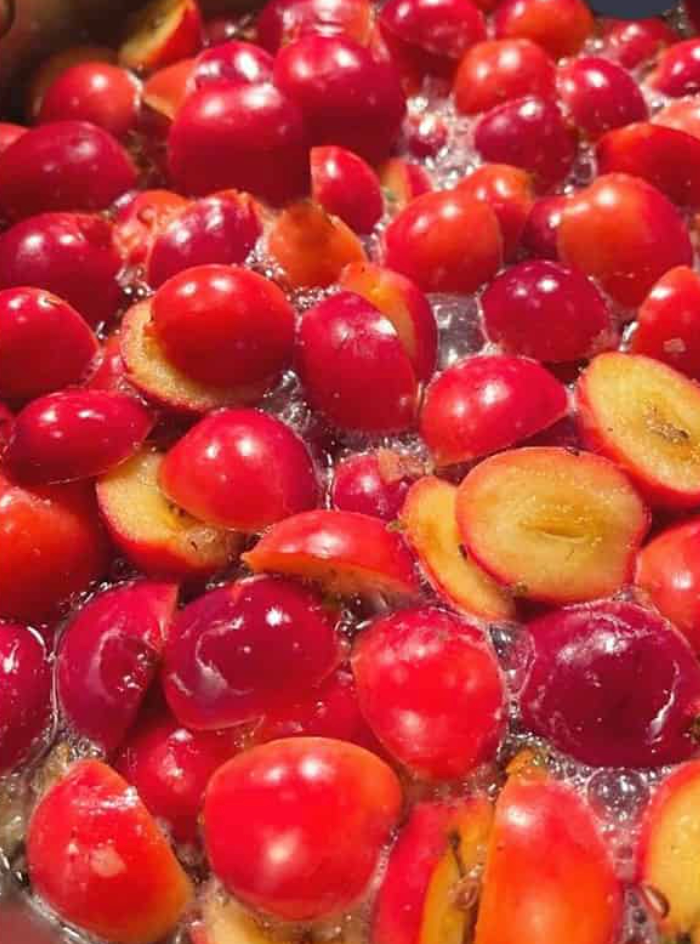Crabapples are grown all over the world and belong to the genus Malus which derives from the Latin word for sour – something anyone who’s ever had a crabapple can attest to. They are grown mainly as decorative trees because they flower beautifully and have nice fall colour. They also serve as vehicles for cross-pollination in apple orchards.
There are many varieties of Crabappple, the defining characteristic being that they are not more than 2 inches in diameter. The ones most people know and use for jelly are the Dolgo Crabapple which are prairie hardy.
Apart from their beauty, Dolgo crabapples are delicious. They make wonderful red clear jelly that is relatively easy to make given their high pectin content which enables easy setting.
Our Crabapple Jelly is the best kind of artisanal product. We use Dolgo Crabapples from around the city of Calgary. The apples are cooked and the juices strained out, then cooked with sugar to make this beautiful and traditional prairie treat. The promise held in the beautiful blossoms the tree produces in spring comes through in the jelly. One associates Crabapple trees with older neighbourhoods and I’m not sure you can be a kid from the prairies if you didn’t steal crabapples from your neighbours to eat or toss at your friends. Many of the new subdivisions in Calgary have Dolgo trees, as well as other varieties. In our opinion, Dolgo trees produce the best fruit and their defining characteristics are that they are oval in shape and bright red when ripe. It can be confusing as there are a number of varieties of crabapple that are ornamental and look much like Dolgos. Simply tasting the fruit will not tell you if it will make good jelly. You need to take about 2 cups worth of apples, boil them in an equal amount of water and strain the juice. At this stage, add sugar (1:1 ratio of juice to sugar) and cook to see if it sets easily. You will find that there are varieties that have no flavour whatsoever if cooked. You will also find that there are varieties that do not have enough pectin to get them to set.
Crabapple jelly is good on cheese, sandwiches, toast, and also good with chicken as a sister to cranberry sauce. So go ahead, next year, when the apples are ripe, pick a bowlful and give it a try.
Method for making Crabapple Jelly
We recommend that you don’t use pectin for the Dolgo Crab Apple jelly. Instead, use the natural pectin in the fruit. Having said that, we’ll outline our process which you will find to be adaptable to the quantity you wish to produce be it two jars or twenty.
The apples need to be processed quite quickly after having been picked. If you cannot get to them that day, leave in the container and leave outside overnight. It is usually chilly enough at that time of year on the prairies. Do not wash them at this point. They will begin to spoil quickly if you do.
When you are ready, rinse the apples off and place in a large kettle or pot. You do not need to remove the stems or the flowering ends. Fill the pot with water just until you can see the water among the apples. One of the rules of making jams or jellies is that any extra water that you add will need to be cooked off at some point. So, using less to begin with saves you time which is important because longer cooking times equate with caramelized sugar tastes in the jam or jelly. Bring the pot to a boil and then simmer for 20 full minutes. Stir occasionally. The apples will begin to break down, but not turn to mush. While the apples are simmering, line a colander with cheesecloth. If you don’t use cheesecloth, you will get tiny particles of apple in the jelly. And then you will not be able to read the newspaper through the jar. Leave it to drip for a minimum of 2 hours. You can leave it overnight but we have found that only about another tablespoon or so of juice is produced.
Once you are satisfied that you have as much juice as you are prepared to wait for, measure the juice into a pot. If you have a large quantity, it’s best not to exceed 6 cups of juice at a time (1500 ml). Add sugar in a 1:1 ratio. Stir the sugar well (we use a whisk). Bring to a boil and continue to boil until the jelly sheets off a spoon. Note: You will be tempted to use less sugar. If you do, be prepared to cook it for much longer.
Testing for Sheeting: Raise the spoon out of the steam, about 30 cm (12 inches) above the pan. Turn the spoon so the liquid runs off the bottom. The jelly is done when the syrup forms two drops that flow together and form a tiny sheet that hangs off the edge of the spoon. There are visuals of this on You Tube.
You are now ready to pour the jelly into jars. Remember – always use jars that have been washed in hot, soapy water and then sterilized in boiling water. When jarred, let it sit for 24 hours before moving. If you do choose to water bath the jelly, have it in the hot water no more than about 5 minutes or the set will be affected.

